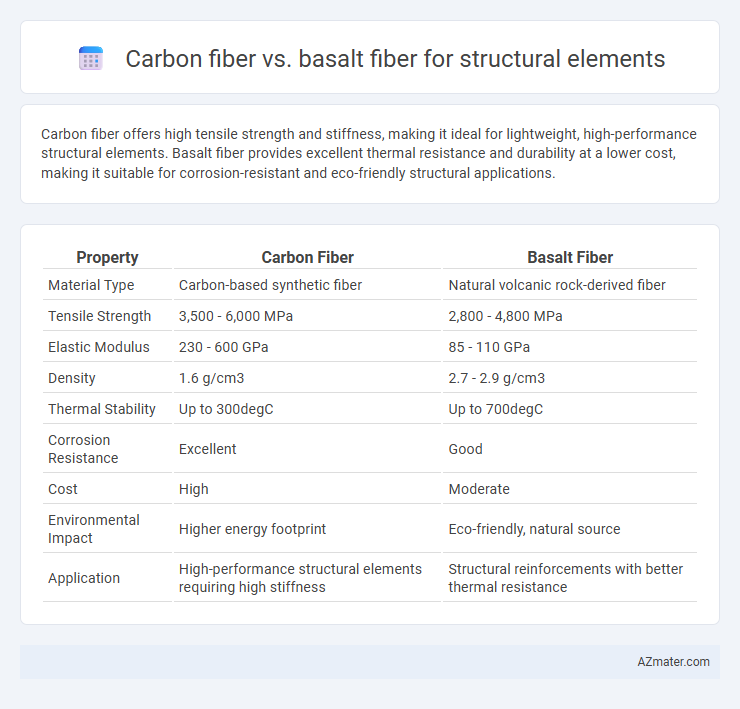Carbon fiber offers high tensile strength and stiffness, making it ideal for lightweight, high-performance structural elements. Basalt fiber provides excellent thermal resistance and durability at a lower cost, making it suitable for corrosion-resistant and eco-friendly structural applications.
Table of Comparison
| Property | Carbon Fiber | Basalt Fiber |
|---|---|---|
| Material Type | Carbon-based synthetic fiber | Natural volcanic rock-derived fiber |
| Tensile Strength | 3,500 - 6,000 MPa | 2,800 - 4,800 MPa |
| Elastic Modulus | 230 - 600 GPa | 85 - 110 GPa |
| Density | 1.6 g/cm3 | 2.7 - 2.9 g/cm3 |
| Thermal Stability | Up to 300degC | Up to 700degC |
| Corrosion Resistance | Excellent | Good |
| Cost | High | Moderate |
| Environmental Impact | Higher energy footprint | Eco-friendly, natural source |
| Application | High-performance structural elements requiring high stiffness | Structural reinforcements with better thermal resistance |
Introduction to Carbon Fiber and Basalt Fiber
Carbon fiber is a high-strength, lightweight composite material composed of thin carbon strands, known for its exceptional tensile strength, stiffness, and resistance to corrosion, making it ideal for structural elements in aerospace, automotive, and civil engineering. Basalt fiber, derived from naturally occurring volcanic rock, offers a cost-effective alternative with remarkable thermal stability, chemical resistance, and mechanical properties, making it suitable for reinforcing concrete and composite structures. Both fibers provide enhanced durability and performance, but carbon fiber typically outperforms basalt fiber in strength-to-weight ratio, while basalt fiber excels in environmental sustainability and cost efficiency.
Material Composition and Manufacturing Process
Carbon fiber consists of thin strands of carbon atoms bonded in a crystal structure, produced primarily through the pyrolysis of polyacrylonitrile (PAN) precursors at high temperatures in an inert atmosphere. Basalt fiber originates from volcanic basalt rock melted at approximately 1400degC and extruded into filaments without any chemical additives, making it a natural inorganic fiber. The manufacturing process of carbon fiber is more energy-intensive and expensive due to high-temperature stabilization, carbonization, and surface treatment stages, while basalt fiber production is simpler and cost-effective, involving melting and fiberizing basalt rock with minimal processing steps.
Mechanical Properties Comparison
Carbon fiber exhibits superior tensile strength, typically ranging from 3,500 to 6,000 MPa, and a high modulus of elasticity around 230 to 600 GPa, making it ideal for high-performance structural elements requiring rigidity and lightweight properties. Basalt fiber, with tensile strengths between 2,800 and 4,800 MPa and a modulus of elasticity ranging from 85 to 110 GPa, offers good durability and impact resistance while being more cost-effective and environmentally friendly. Both fibers provide excellent corrosion resistance and thermal stability, but carbon fiber's higher stiffness and strength-to-weight ratio make it preferable for critical load-bearing applications.
Weight and Density Differences
Carbon fiber offers a superior strength-to-weight ratio with a density around 1.6 g/cm3, making it significantly lighter than basalt fiber, which has a density of approximately 2.7 to 3.0 g/cm3. This density difference makes carbon fiber ideal for structural elements requiring minimal weight without compromising performance. Basalt fiber's higher density results in increased weight, making it less advantageous for applications where weight reduction is crucial.
Durability and Environmental Resistance
Carbon fiber exhibits exceptional durability and high resistance to environmental factors such as moisture, UV radiation, and temperature fluctuations, making it ideal for long-term structural applications. Basalt fiber offers strong environmental resistance, particularly in alkaline and corrosive environments, with durability comparable to glass fibers but generally lower than carbon fiber under extreme conditions. Both fibers enhance structural integrity, with carbon fiber favored for high-performance uses due to superior strength-to-weight ratio and longevity in harsh settings.
Cost Analysis: Carbon Fiber vs Basalt Fiber
Carbon fiber offers superior strength-to-weight ratio and stiffness but comes at a significantly higher cost, often three to five times that of basalt fiber. Basalt fiber provides a cost-effective alternative with comparable durability and better thermal resistance, making it suitable for large-scale structural elements where budget constraints are critical. Evaluating lifecycle costs reveals basalt fiber's affordability and maintenance advantages, while carbon fiber excels in high-performance, lightweight structural applications.
Structural Performance in Construction Applications
Carbon fiber exhibits superior tensile strength and stiffness compared to basalt fiber, making it highly effective for reinforcing structural elements in construction applications requiring high load-bearing capacity and fatigue resistance. Basalt fiber offers excellent thermal stability and corrosion resistance, providing enhanced durability in harsh environmental conditions, though with slightly lower mechanical performance than carbon fiber. The choice between carbon fiber and basalt fiber hinges on balancing cost-efficiency with specific structural performance requirements such as strength-to-weight ratio, durability, and environmental resilience.
Sustainability and Environmental Impact
Carbon fiber offers high strength-to-weight ratio but requires energy-intensive production processes with significant carbon emissions, challenging its sustainability. Basalt fiber, derived from natural volcanic rock, presents a more eco-friendly alternative with lower energy consumption, biodegradability, and reduced environmental toxicity. Life cycle assessments indicate basalt fiber's superior environmental profile, promoting its use in sustainable structural elements.
Typical Use Cases and Industry Applications
Carbon fiber is extensively used in aerospace, automotive, and sports equipment industries due to its high strength-to-weight ratio and stiffness, ideal for load-bearing structural elements requiring lightweight materials. Basalt fiber, known for its excellent thermal resistance and cost-effectiveness, finds applications in civil infrastructure, wind energy, and construction sectors where durability and resistance to environmental degradation are crucial. Both materials offer superior mechanical properties, but carbon fiber dominates high-performance applications, while basalt fiber suits large-scale, budget-conscious projects demanding corrosion resistance.
Conclusion: Choosing the Right Fiber for Structural Elements
Carbon fiber offers superior tensile strength, stiffness, and lightweight properties ideal for high-performance structural elements requiring maximum durability and minimal weight. Basalt fiber provides excellent thermal resistance, corrosion resistance, and cost-effectiveness, making it suitable for applications with harsh environmental conditions and budget constraints. Selecting the right fiber depends on balancing performance requirements, environmental factors, and budget limitations to ensure optimal structural integrity and longevity.

Infographic: Carbon fiber vs Basalt fiber for Structural element
 azmater.com
azmater.com